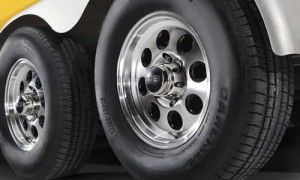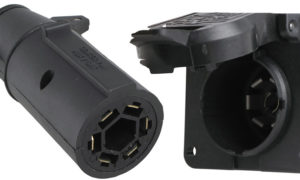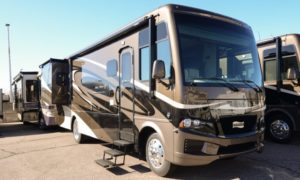
Last updated on April 27th, 2009 at 06:52 pm
One of the most important and often overlooked items on an towable RV are the tires. Most travel trailer or 5th wheel tires are barely adequate for the load they are carrying as many manufacturers use the cheapest tires possible to save money. To ensure your tires are up to the task of safely supporting your expensive home on wheels, follow these steps for selecting and maintaining your RV tires.
The first step is to look for special trailer tires, which are designated with an ST in front of a series of numbers on the sidewall. These are designed with RV trailers in mind. They have stiffer sidewalls than a passenger (P) or light truck (LT) tire, are more flexible when cornering and backing, and are designed for extended, non-stop towing. However, LT tires are can be substituted for ST tires if greater load carrying capacity is required.
Next, you will need to know the weight of your fully loaded RV. You can weigh your RV at a local scale. And it is a good idea to do so since RV manufacturer’s numbers are almost always low. This information is critical in determining the load range (weight capacity) of each tire on the RV. Trailer tire load ranges are identified by a letter, usually B, C, or D. LT rated tires are identified with a D or E. The higher the letter, the more load the tire can carry. But remember that RV tires work in conjunction with the axles and other suspension components. Just because you have a high load range tire doesn’t mean you can exceed the axle ratings.
Now that you know the total weight of the RV, you need determine which load range will work for that weight. If you cannot weigh your RV, use the Gross Vehicle Weight Rating (GVWR) of the RV found on the weight specifications sticker. If you have a single axle towable RV, divide the total weight by 2. If you have a 2 axle towable RV, divide by 4.
Have the tires professionally mounted AND balanced. Most RV tires are not balanced from the factory and can lead to tire failure if they are not balanced correctly. Here are some more tips about choosing the right tires for your towable RV:
- Any tire on an RV that is over five years old should be inspected by a competent tire professional for cracking, and possible replacement, even if it has no apparent tread wear. This is because a tire on a car or truck might last 80,000 to 100,000 miles before it needs to be replaced, but an RV tire that only travels 5,000 miles per year will not approach that mileage for 20 years. It will need to be replaced long before that.
- If you have a 5th wheel and need more clearance between your truck bed rails and the 5th wheel overhang, substituting taller tires can help. By using a 2 inch taller tire, for example, it’s possible to gain an inch or so of clearance since the 5th wheel will sit up higher. Just be sure that the taller tires do not interfere with the wheel wells on the 5th wheel when the suspension deflects.
- It is very important that your towable RV is as level as possible when towing, especially if the RV has 2 or more axles. If the front of the RV, for example, is too low, the front axle of the RV will be supporting more weight than it was designed for. This can cause damage to the axle and possibly overload the tires on that axle, causing a blowout.
Copyright 2009 by Mark Corgan, owner of ModMyRV.com
Subscribe to our ModMyRV.com Mod Feed at http://www.feedburner.com/fb/a/emailverifySubmit?feedId=2010518
Or visit us at http://www.modmyrv.com, the only site that’s just about making mods to your RV.
Article Source
Jim Foreman is a well-known and popular member of several RV email groups and forums so you may already know that he loves to cook cowboy style.
As an avid RVer, Jim found that his cowboy recipes and style of cooking adapted well to the confines of his RV kitchen and his cookbook is a combination of cowboy, tex-mex, Baja Califonia and just good food influenced by many years and miles of RV travel. Get More Info






